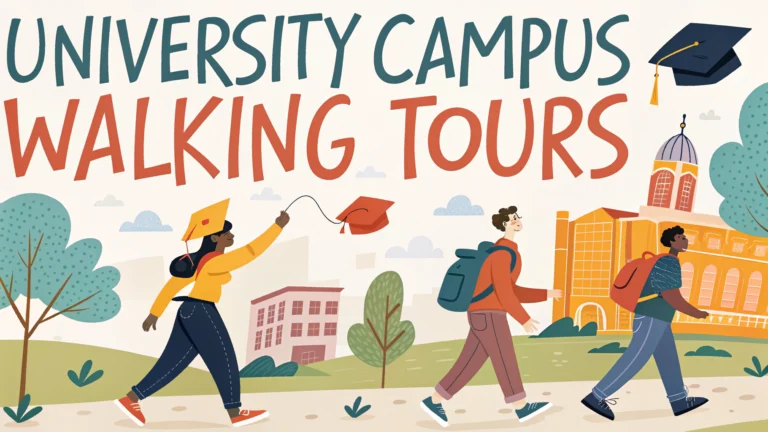A self-guided campus walking tour lets you explore at your own pace while discovering what makes each university unique.
Planning Your Campus Tour
Most universities offer downloadable campus maps and tour routes through their admissions or visitor relations websites.
- Download the official campus map beforehand
- Check visitor parking locations and fees
- Verify building access hours and restrictions
- Look up special exhibits or events happening during your visit
- Choose comfortable walking shoes and weather-appropriate clothing
Key Places to Visit
- Student Center/Union: Hub of campus life and activities
- Libraries: Study spaces and academic resources
- Academic Buildings: Classrooms and department offices for your intended major
- Dining Halls: Food options and meal plan facilities
- Recreation Centers: Fitness facilities and sports venues
- Residence Halls: Student housing options (note: many require escort access)
Making the Most of Your Visit
Take photos and notes of specific features that interest you for later comparison with other schools.
Visit during regular class hours to experience the authentic campus atmosphere.
Talk to current students when possible – most are happy to share their experiences.
Smart Tour Tips
- Use campus WiFi (most universities offer guest access)
- Check out bulletin boards for current student activities
- Visit the campus bookstore for university merchandise
- Try eating at a campus dining facility
- Walk through surrounding neighborhoods to get a feel for off-campus life
Technology Tools
Many universities now offer mobile apps with interactive maps, points of interest, and virtual tour features.
| Tool Type | Benefits |
|---|---|
| University Apps | Campus-specific information, real-time updates |
| Google Maps | Navigation, street view options |
| Virtual Tour Platforms | 360-degree views, building interiors |
Safety Considerations
- Save campus security numbers in your phone
- Stay on marked paths and well-lit areas
- Check in with the visitor center upon arrival
- Follow posted signs and access restrictions
Contact the university’s visitor center or admissions office ahead of time for specific tour information and campus policies.
Best Times to Visit
- Weekdays during regular semester sessions
- Avoid finals week and major campus events
- Morning tours offer less crowded conditions
- Spring and fall provide optimal weather conditions
- Consider visiting during admitted student days
Documentation Needs
- Valid photo ID for building access
- Printed campus map (backup for digital)
- Visitor parking permit if required
- Campus tour confirmation details
Beyond the Main Campus
Explore additional facilities that may be relevant to your interests:
- Research Centers: Specialized laboratories and facilities
- Performance Venues: Theaters, concert halls, art galleries
- Athletic Facilities: Stadiums, training centers, fields
- Transportation Hubs: Bus stops, shuttle services, bike shares
Conclusion
A self-guided campus tour provides valuable insights into university life and campus culture. Take time to explore thoroughly, document your observations, and imagine yourself as part of the community. Compare multiple campuses to find the best fit for your academic and personal goals.
Post-Tour Actions
- Review your notes and photos
- List follow-up questions for admissions
- Compare campus features with your priorities
- Consider scheduling an official tour if needed
FAQs
- How long does a typical university campus walking tour take?
Most self-guided campus tours take between 60-90 minutes to complete when walking at a comfortable pace and stopping at major points of interest. - What are the best times to take a self-guided campus tour?
Weekdays during regular class sessions (typically 9am-3pm) offer the most authentic campus atmosphere, while avoiding peak class transition times. Avoid major events, holidays, and weekends when buildings may be closed. - Do I need to download any special apps or maps for a self-guided tour?
Most universities offer downloadable campus maps, and many have dedicated mobile apps or interactive maps on their websites. Some institutions also provide QR codes at key locations for additional information. - Which campus buildings are typically accessible during self-guided tours?
Common areas of academic buildings, libraries, student centers, and outdoor spaces are usually accessible. However, residence halls, research facilities, and administrative buildings may require official accompaniment. - Should I make any arrangements with the university before doing a self-guided tour?
While not always required, it’s recommended to check the university’s website or contact the admissions office for visitor parking information and to verify building access policies. - What should I bring on a self-guided campus tour?
Comfortable walking shoes, weather-appropriate clothing, water, a charged phone for maps and photos, and a notepad for observations. Don’t forget your parking permit if required. - How can I make the most of my self-guided campus tour?
Visit during regular class hours, explore both inside and outside spaces, talk to current students when possible, and document your observations with photos and notes. - Are campus facilities like restrooms and water fountains accessible to visitors?
Yes, most campus buildings have publicly accessible restrooms and water fountains, typically located in main lobbies or common areas. - What key locations should I include on my self-guided tour?
Visit the main library, student center, academic buildings relevant to your interests, dining facilities, recreation centers, central quad or green spaces, and any iconic campus landmarks. - Is it safe to do a self-guided campus tour alone?
Most university campuses are generally safe during daylight hours, but it’s always wise to stay in well-populated areas, be aware of your surroundings, and know how to contact campus security if needed.








